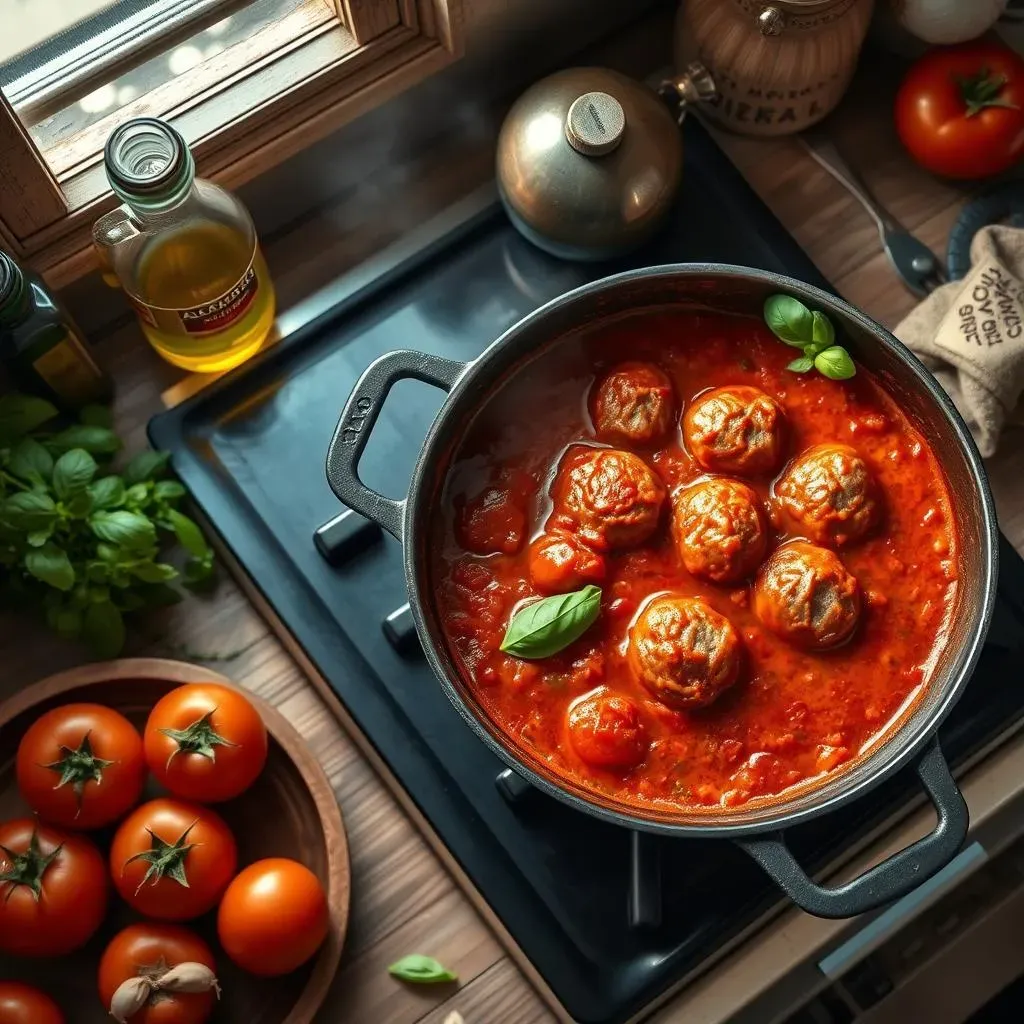Is there anything more comforting than a plate of spaghetti and meatballs? The aroma of simmering tomato sauce, the tender bite of a perfectly cooked meatball – it's a classic for a reason. But forget the frozen, store-bought stuff! We're diving headfirst into the world of homemade Italian meatball recipes, and trust me, once you taste the difference, you'll never go back.
The Foundation: Essential Ingredients for Authentic Homemade Italian Meatball Recipes

The Foundation: Essential Ingredients for Authentic Homemade Italian Meatball Recipes
The Meat of the Matter: Choosing Your Ground Meat
Alright, let's talk meat! This is where the magic begins with homemade Italian meatball recipes. You've got options, and the blend you choose will significantly impact the flavor and texture of your final product. Traditionally, a combination of ground beef and ground pork is the way to go. The beef provides that classic meaty flavor, while the pork adds richness and helps keep the meatballs nice and moist.
But hey, don't be afraid to experiment! Some folks swear by adding ground veal to the mix for an even more tender result. Others prefer using ground turkey or chicken for a leaner option. If you're going the poultry route, just be sure to add a little extra fat (like olive oil or a touch more egg) to prevent them from drying out. Remember, the key is to use meat with a good amount of fat marbling. That fat renders during cooking, keeping the meatballs juicy and flavorful.
Breadcrumbs and Binding: Adding Moisture and Structure
Now, for the unsung hero of many homemade Italian meatball recipes: breadcrumbs! But not just any breadcrumbs – we're talking about the secret weapon of stale bread soaked in milk. This technique, often used in classic recipes, adds a ton of moisture to the meatballs, ensuring they stay tender and juicy even after cooking. The milk-soaked bread also acts as a binder, helping to hold everything together without making the meatballs dense or tough.
You can use store-bought breadcrumbs in a pinch, but for the best results, I highly recommend making your own. Simply take some day-old Italian or French bread, remove the crust, and soak the interior in milk for a few minutes. Then, squeeze out the excess milk and crumble the bread into small pieces. This mixture, along with an egg, will provide the perfect amount of moisture and binding power for your meatballs.
Ingredient | Purpose | Notes |
|---|---|---|
Ground Beef | Flavor, Structure | Look for chuck with good marbling. |
Ground Pork | Richness, Moisture | Adds a distinct flavor profile. |
Breadcrumbs (soaked in milk) | Moisture, Binding | Use stale Italian or French bread. |
Egg | Binding | Helps hold the meatballs together. |
Mixing Magic: StepbyStep Guide to Crafting the Perfect Meatball Mixture

Mixing Magic: StepbyStep Guide to Crafting the Perfect Meatball Mixture
The Gentle Touch: Combining Ingredients Without Overworking
Alright, you've got your ingredients prepped and ready to go. Now comes the crucial part: mixing everything together for your homemade Italian meatball recipes. The key here is a gentle touch. Overworking the mixture will result in tough, dense meatballs, and nobody wants that! Think of it like you're folding in delicate egg whites – you want to combine everything thoroughly, but without crushing the ingredients or developing too much gluten.
Start by placing all your ingredients in a large bowl. Use your hands (yes, get in there!) to gently combine everything. I like to start by breaking up the ground meat with my fingers, then gradually incorporating the breadcrumb mixture, eggs, cheese, and seasonings. Mix until everything is just combined – you should still see some distinct pieces of each ingredient.
Seasoning Secrets: Achieving the Perfect Flavor Profile
Seasoning is where you can really put your personal stamp on your homemade Italian meatball recipes. While there are some classic flavors that are essential (we'll get to those in a sec), don't be afraid to experiment and adjust the seasonings to your liking.
The foundation of any good meatball seasoning blend includes garlic (minced or powdered), Italian seasoning (a blend of dried herbs like oregano, basil, rosemary, and thyme), salt, and black pepper. Some people also like to add a pinch of red pepper flakes for a little heat. But the real secret ingredient? Freshly grated Parmesan cheese! It adds a salty, umami-rich flavor that takes these meatballs to the next level.
Once you've added your seasonings, give the mixture a gentle mix and then do a taste test. The best way to do this is to cook a tiny bit of the mixture in a skillet and then taste it. This will allow you to adjust the seasonings before you form all the meatballs.
Rolling with It: Forming Uniform Meatballs
Now for the fun part: rolling your homemade Italian meatball recipes! This is where presentation comes into play. You want to aim for meatballs that are uniform in size and shape, so they cook evenly.
I like to use a cookie scoop to portion out the meatball mixture, then gently roll each portion between my palms to form a smooth, round ball. Don't press too hard, or you'll end up with dense meatballs. Aim for a size that's about 1.5 to 2 inches in diameter – this will give you a good balance of surface area for browning and a juicy interior.
As you roll the meatballs, place them on a baking sheet lined with parchment paper. This will prevent them from sticking and make cleanup a breeze. Once you've rolled all the meatballs, you're ready to cook them!
Step | Description | Tips |
|---|---|---|
1. Combine | Gently mix all ingredients in a large bowl. | Avoid overmixing to prevent tough meatballs. |
2. Season | Add garlic, Italian seasoning, salt, pepper, and Parmesan cheese. | Taste test a small cooked portion to adjust seasonings. |
3. Roll | Use a cookie scoop to portion and gently roll into uniform balls. | Aim for 1.5-2 inch diameter for even cooking. |
Cooking Methods Compared: Frying, Baking, and Simmering Your Homemade Italian Meatballs

Cooking Methods Compared: Frying, Baking, and Simmering Your Homemade Italian Meatballs
Frying: The Quick and Crispy Approach
Alright, let's get down to business with cooking these bad boys! Frying is the method for those who want a quick and crispy exterior on their homemade Italian meatballs. It's all about searing the outside to create a flavorful crust while keeping the inside nice and juicy.
To fry, heat a generous amount of olive oil in a large skillet over medium-high heat. Once the oil is hot, carefully add the meatballs, making sure not to overcrowd the pan. Cook for about 2-3 minutes per side, until they're nicely browned all over. Remove the meatballs from the skillet and set them aside on a plate lined with paper towels to drain any excess oil.
Baking: The Hands-Off and Healthy Option
If you're looking for a more hands-off and slightly healthier way to cook your homemade Italian meatballs, baking is the way to go. This method allows the meatballs to cook evenly without the need for constant attention, and it also reduces the amount of oil used.
To bake, preheat your oven to 375°F (190°C). Place the meatballs on a baking sheet lined with parchment paper and bake for about 20-25 minutes, or until they're cooked through and lightly browned. You can also broil them for the last few minutes to get an even crispier exterior.
Method | Pros | Cons |
|---|---|---|
Frying | Quick, crispy exterior, flavorful | Requires more oil, needs constant attention |
Baking | Hands-off, healthier, even cooking | Can be less flavorful, may require broiling |
Sauce It Up: Complementing Your Meatballs with the Ideal Tomato Sauce

Sauce It Up: Complementing Your Meatballs with the Ideal Tomato Sauce
The Heart of Italian Cooking: Making a Simple Tomato Sauce
Alright, you've got these amazing homemade Italian meatballs, but they're just begging for a bath in some delicious tomato sauce. And let me tell you, the sauce can make or break the whole dish! Forget the jarred stuff – we're talking about a simple, homemade tomato sauce that's bursting with flavor and complements the meatballs perfectly.
The beauty of a good tomato sauce is its simplicity. All you need are a few key ingredients: canned crushed tomatoes (San Marzano are the gold standard, if you can find them), garlic, olive oil, dried oregano, salt, and pepper. Some people also like to add a pinch of sugar to balance the acidity of the tomatoes, but that's totally optional.
Building Flavor: Sautéing Aromatics and Simmering to Perfection
The key to a flavorful tomato sauce is to build the flavors slowly. Start by sautéing some minced garlic in olive oil over medium heat until it's fragrant (be careful not to burn it!). Then, add the crushed tomatoes, oregano, salt, and pepper. Bring the sauce to a simmer, then reduce the heat to low and let it simmer for at least 30 minutes, or even longer if you have the time. The longer it simmers, the more the flavors will meld together and the richer the sauce will become.
During the simmering process, taste the sauce and adjust the seasonings as needed. If it's too acidic, add a pinch of sugar. If it needs more depth, add a bay leaf or a Parmesan cheese rind (remove it before serving!). And if you want to get really fancy, you can add a splash of red wine to the sauce while it's simmering.
Marrying the Flavors: Simmering Meatballs in Sauce
Once your tomato sauce is simmering away, it's time to introduce the meatballs! Gently nestle the cooked meatballs into the sauce, making sure they're mostly submerged. Then, cover the pot and let the meatballs simmer in the sauce for at least another 30 minutes, or even longer. This will allow the meatballs to absorb the flavors of the sauce and become even more tender and juicy.
During this final simmering stage, the meatballs and sauce will become one harmonious dish. The flavors will meld together, creating a symphony of Italian goodness that will have your taste buds singing. And the best part? Your house will smell absolutely incredible!
Step | Description | Tips |
|---|---|---|
1. Sauté Aromatics | Sauté minced garlic in olive oil until fragrant. | Be careful not to burn the garlic. |
2. Add Tomatoes and Seasonings | Add crushed tomatoes, oregano, salt, and pepper. | Use high-quality canned tomatoes for best results. |
3. Simmer Sauce | Simmer for at least 30 minutes, or longer for richer flavor. | Taste and adjust seasonings as needed. |
4. Add Meatballs | Gently nestle meatballs into the sauce. | Simmer for another 30 minutes to allow flavors to meld. |
Serving and Storing: Enjoying and Preserving Your Delicious Homemade Italian Meatball Recipes

Serving and Storing: Enjoying and Preserving Your Delicious Homemade Italian Meatball Recipes
Serving Suggestions: From Classic to Creative
Alright, you've got a pot of simmering homemade Italian meatballs in a luscious tomato sauce – now what? Well, the classic choice is, of course, serving them over a bed of spaghetti. But don't feel limited to just that! There are tons of other ways to enjoy these little balls of deliciousness.
For a hearty and satisfying meal, try serving them with creamy polenta or mashed potatoes. The rich sauce and tender meatballs pair perfectly with the smooth and comforting texture of these sides. You could also use them to make meatball subs, stuffed peppers, or even meatball pizza! And if you're looking for a lighter option, try serving them over a bed of zucchini noodles or in a hearty vegetable soup.
Storing and Reheating: Keeping the Flavor Alive
So, you've made a big batch of homemade Italian meatballs, but you can't possibly eat them all in one sitting? No problem! These meatballs store beautifully, and they're just as delicious (if not more so) the next day.
To store, simply let the meatballs and sauce cool completely, then transfer them to an airtight container and refrigerate for up to 3-4 days. You can also freeze them for longer storage – just make sure to thaw them completely before reheating. When reheating, you can either simmer them gently in a pot on the stovetop or microwave them until heated through. I personally prefer the stovetop method, as it allows the flavors to meld together even more.
Serving Suggestion | Description |
|---|---|
Spaghetti and Meatballs | The classic choice, served with marinara sauce and Parmesan cheese. |
Meatball Subs | Served in a toasted roll with sauce and melted mozzarella. |
Polenta with Meatballs | Creamy polenta topped with meatballs and sauce. |
Meatball Pizza | Sliced meatballs used as a pizza topping. |
From Our Kitchen to Yours: Mastering Homemade Italian Meatball Recipes
So there you have it – a complete guide to creating unforgettable homemade Italian meatball recipes. From selecting the finest ingredients to mastering various cooking techniques, you now possess the knowledge to impress your family and friends with meatballs that rival any restaurant. Remember, the key to success lies in the details: don't skimp on quality ingredients, handle the mixture gently, and always taste and adjust the seasonings to your liking. Now, go forth and create meatball magic!